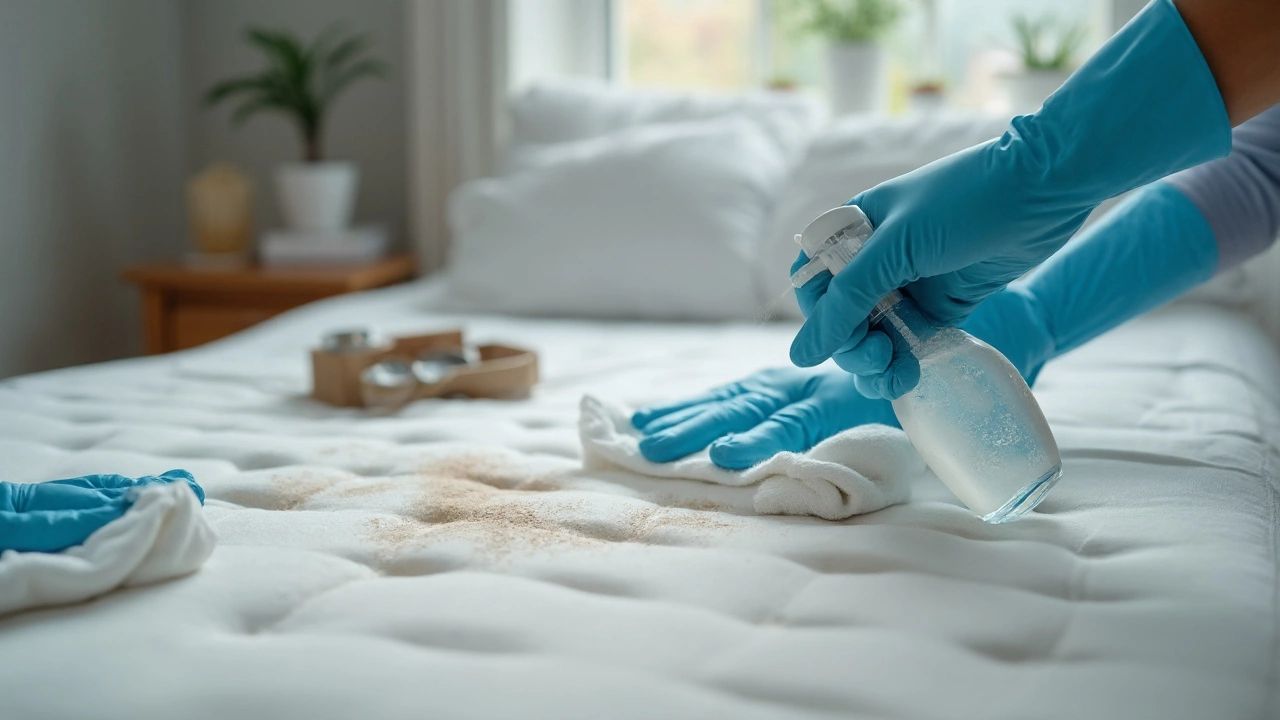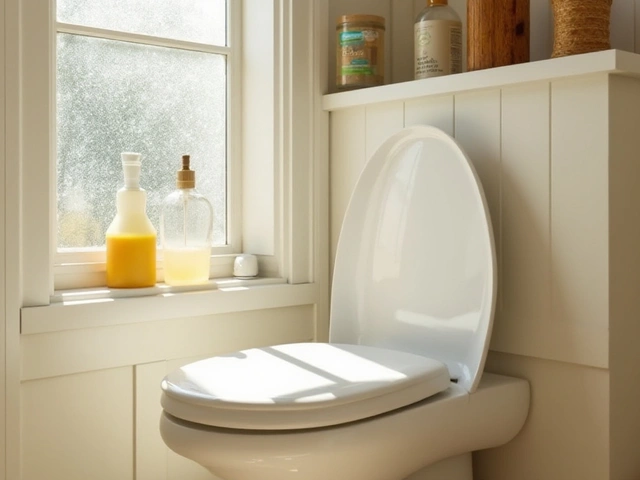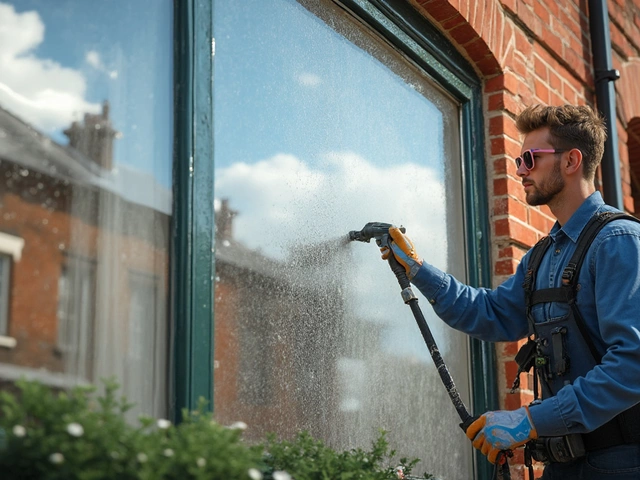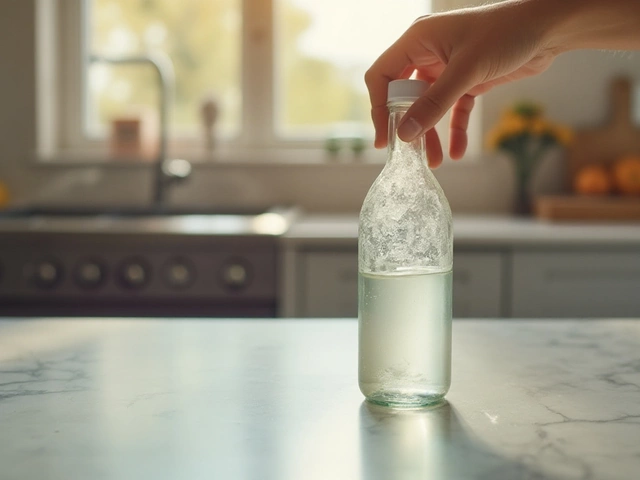Urine odour hangs on because those salts and crystals bind to the foam. Standard soap or a quick spritz won’t touch them. You beat the smell by breaking down uric acid and related compounds, not by masking them. That means enzyme cleaners or an oxidiser (like 3% hydrogen peroxide) used correctly, time on the stain, and proper drying so the smell doesn’t creep back. I’ve handled this more times than I care to admit-kids, house training, a startled cat-and this is what actually works in the real world here in Bath.
TL;DR: What Actually Kills Urine Smell in a Mattress
- The smell source: uric acid salts and ammonia by-products lodged in foam. Water and perfume won’t remove them.
- What kills it: bio-enzymatic cleaners (they digest uric acid) or 3% hydrogen peroxide mixes (they oxidise smell compounds). Vinegar and baking soda help a bit but won’t fully fix old or strong odours.
- Key moves: blot fast, saturate the exact spot with enzyme, give it 15-60 minutes (longer for cat pee), then extract and dry hard (fans, airflow). Repeat if needed. For dry, old stains, an enzyme-peroxide one-two punch works.
- What to avoid: steam (sets odours), too much liquid in memory foam (mould risk), bleach (toxic gases with urine), and strong fragrances (just hides odours).
- Expectations: fresh accidents are usually 1-2 rounds; old or cat urine may take 2-4. If the core is soaked and you can’t dry it, call a pro or consider replacing.
Jobs you’re trying to get done:
- Neutralise the smell quickly (today).
- Lift the stain without ruining the fabric.
- Make sure the stink doesn’t return in a few days.
- Use safe ingredients around kids and pets.
- Know when to escalate (more product, pro help, or replacement).
Step-by-Step: Remove Fresh and Old Pee Smells (That Last)
I’ll give you a quick plan for fresh accidents, then a deeper plan for dried/old stains. This works on springs, latex, and memory foam-just be extra careful with foam so you don’t drown it.
Before you start
- Open windows, get a fan going. Airflow matters.
- Test any cleaner on a hidden patch for colourfastness, especially with hydrogen peroxide (3%).
- Never mix bleach with anything urine-contaminated (ammonia + bleach = toxic gases). The CDC warns against this for a reason.
Fresh accident (still damp)
- Blot hard, don’t rub. Use white towels or paper towels. Stand on a folded towel to pull moisture up. Keep swapping until almost dry.
- Enzyme flood the spot. Use a bio-enzymatic urine odour remover. Apply enough to match how deep the urine went (usually a palm-sized wet zone becomes a dinner-plate-sized treatment zone). Enzymes need contact to digest uric acid and urea.
- Dwell time: 15-30 minutes. For cat urine or strong smell, 45-60 minutes. Keep the area damp with enzyme, not dripping.
- Extract. Blot again with fresh towels. If you have a wet/dry vac or a carpet spot extractor, use it (no heat). You’re pulling the broken-down residue out.
- Light rinse (optional). Mist with clean water and blot once more. Don’t soak memory foam.
- Deodorise and dry. Sprinkle a thin layer of baking soda over the damp area. Leave 4-8 hours, then vacuum. Run a fan for 12-24 hours. Flip the mattress if design allows so air can move through. No heaters or steam.
Dried or old stain (the room smells, or you can see the mark)
- Find the whole spot. Urine spreads. A cheap UV torch makes dried urine glow pale yellow/green so you treat the right area.
- Pre-treat with enzyme. Apply enzyme cleaner liberally. Work from the outside in so you don’t push it wider. Dwell 45-60 minutes; cover with cling film if it dries too fast.
- Extract thoroughly. Heavy blotting or wet/dry vac. This step matters. If you leave the broken-down gunk in the foam, the smell lingers.
- Oxidise if smell remains. Mix a fresh solution: 240 ml (1 cup) of 3% hydrogen peroxide + 1 tablespoon baking soda + 1-2 drops of mild dish soap. Stir gently. Use immediately; don’t store sealed (gas buildup). Lightly apply to the spot; don’t drench. Dwell 5-10 minutes.
- Blot and air dry. Follow with baking soda once surface is just damp. Vacuum when dry.
- Repeat as needed. Old cat pee can take 2-4 cycles over two days. Stay patient and keep airflow high.
Why this works (plain English)
Urine dries into uric acid crystals and salts. These are stubborn, hydrophobic in parts, and don’t dissolve with plain water. Enzymes (like urease blends) break these down into water-soluble bits that blot out. Oxidisers like hydrogen peroxide attack the smell molecules directly. Vinegar changes pH and helps with ammonia odour but doesn’t fully break uric acid crystals. Baking soda absorbs moisture and odour but can’t digest the source. That’s why enzyme + time + extraction is the winning combo.
Safety and fabric care
- Memory foam: use less liquid and longer dry time. Never saturate to the core. Foam that stays damp can grow mould.
- Coloured ticking (fabric cover): patch test peroxide. It can lighten dyes.
- No steam cleaners: heat sets proteins and odours. Also drives moisture deep.
- Manufacturer advice: many memory foam brands (e.g., Tempur) recommend gentle spot cleaning and thorough drying. Respect the warranty care guide.
Real-world example
When we were potty-training, I missed a late-night accident. By morning the room in our Bath terrace smelt like a cat flap. Enzyme soak (45 minutes), long blot, then a light peroxide pass. Fan overnight. Next day, no whiff. Deirdre said the room smelled normal again, and that’s the only review that counts in our house.
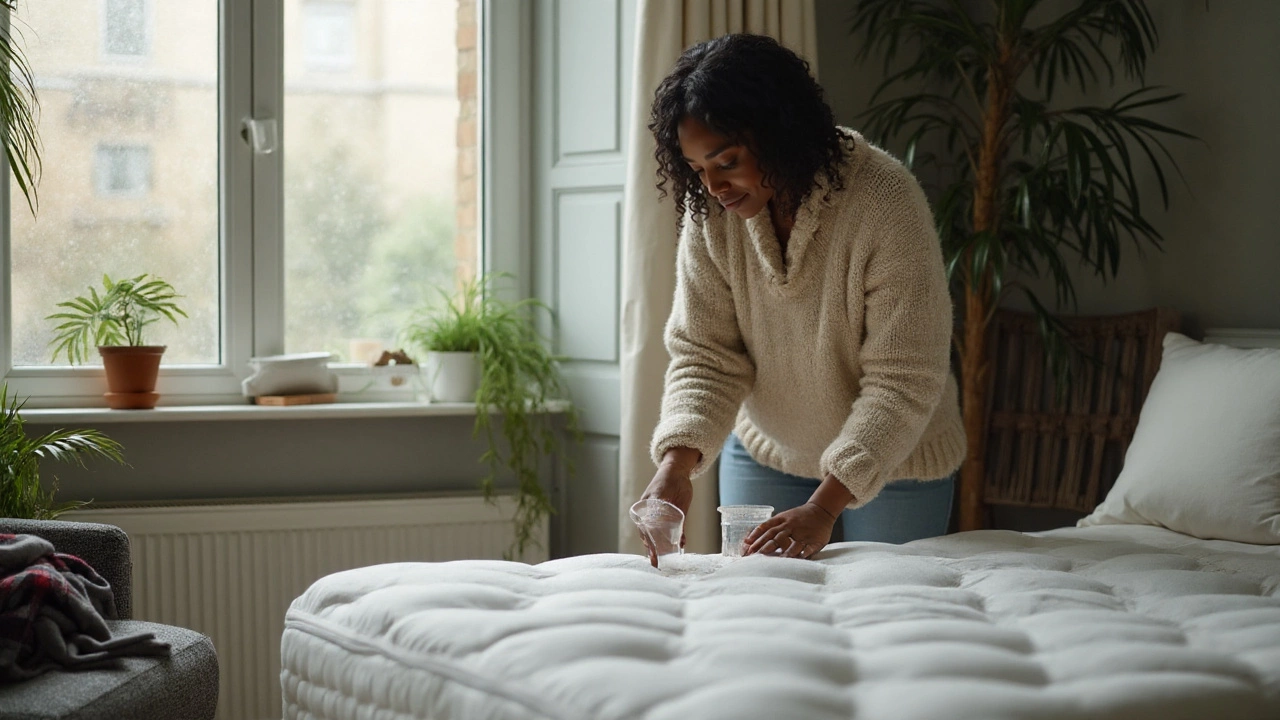
Cheat Sheets, Ratios, and What Works vs What Doesn’t
Here’s the quick reference I wish I had the first time. Use this to choose your method and avoid dead ends.
| Method | What it does | Typical dwell | Best for | Pros | Cons | Notes |
|---|---|---|---|---|---|---|
| Bio-enzymatic cleaner | Digests uric acid and proteins | 15-60 min | Fresh & old urine; cats/dogs | Targets source; safe when used right | Needs time; may need repeats | Keep damp during dwell; extract after |
| 3% Hydrogen peroxide mix | Oxidises smell compounds | 5-10 min | Old stains, lingering odour | Fast; cheap | May lighten dyes; foam caution | Use fresh; don’t store sealed |
| Vinegar (diluted 1:1) | Shifts pH; reduces ammonia odour | 10-15 min | Mild fresh accidents | Safe, easy | Doesn’t break uric crystals | Follow with enzyme for best results |
| Baking soda (dry) | Adsorbs odour and moisture | 4-12 hrs | Final deodorise & dry | Safe, gentle | Doesn’t remove source | Vacuum thoroughly after |
| Steam cleaning | Heat + moisture | - | None (avoid) | - | Sets odour; mould risk | Skip it on mattresses |
| Bleach | Disinfects/whitens | - | Hard surfaces only | Strong oxidiser | Hazardous with ammonia/urine | Don’t use on mattresses |
Ratios and recipes
- Enzyme cleaner: use undiluted unless label says otherwise. Apply enough to penetrate as deep as the urine went. Keep the area damp during dwell, not soaked.
- Peroxide mix: 240 ml (1 cup) 3% hydrogen peroxide + 1 tablespoon baking soda + 1-2 drops dish soap. Mix, use within 20 minutes, do not cap tightly.
- Vinegar rinse (optional): 1:1 white vinegar and water, light mist only. Follow with enzyme for a full fix.
Quick decision guide
- If it’s fresh and still wet → Blot → Enzyme 20-30 min → Extract → Baking soda → Dry.
- If it’s dried and smelly → Enzyme 45-60 min → Extract → Peroxide pass → Baking soda → Dry → Repeat if needed.
- If it’s cat urine → Plan on 2-4 cycles. Be patient. Cat urine has sulphur-containing compounds that are stubborn.
- If the core is soaked (squishy, cold, smells days later) → You need serious drying airflow or a pro with extraction. Otherwise, replacement may be cheaper than chasing odour.
Don’t waste your time on
- Pure fragrance sprays. They mask for hours, then the odour returns.
- Essential oils. Nice scent, zero chemistry against uric acid.
- Covering with a topper. The smell will vent every time the bed warms up.
How long should it take?
Fresh accidents are often sorted the same day: 1-2 hours total hands-on time plus drying. Old stains can take a weekend-treat, dry, re-treat. A fan shortens the job by half. If the smell is better but not gone after each round, you’re on the right track-keep going.
Costs (UK ballpark)
- Bio-enzymatic cleaner: £6-£15 per bottle (enough for multiple spots).
- Hydrogen peroxide (3%): £1-£3 for 200-500 ml.
- Baking soda: £1-£2 a box.
- UV torch: £8-£15, optional but handy.
FAQ, Troubleshooting, and Next Steps
Does vinegar kill the smell?
Vinegar helps with fresh ammonia odour and shifts pH so some stink calms down. But it doesn’t fully break uric acid crystals. Use it as a helper, not the main act. Enzymes or peroxide do the heavy lifting.
How many times should I repeat?
Keep going until the odour is gone when the mattress is warm and you press your nose near the spot. For tough cases (cat urine, old stains), expect 2-4 cycles. Each round should improve things.
Is hydrogen peroxide safe on mattresses?
3% is considered mild, but it can lighten dyes and foam can be sensitive. Patch test first, use lightly, and focus only on the target area. Never use industrial strengths.
What about children and pets?
Bio-enzymatic cleaners marketed for pet accidents are designed for homes. Follow the label, keep kids and pets off the damp area until it’s dry, and ventilate. Baking soda is safe but don’t let pets lick up wet residues.
Why does the smell come back after a few days?
Two reasons: the urine penetrated deeper than your treatment, or the mattress didn’t dry fully and bacteria kept working. Re-treat with more coverage, extract better, and increase airflow. A small desk fan aimed at the spot for 12-24 hours works wonders.
Can I use a steam cleaner?
Skip it. The heat sets proteins and can trap odour deeper. It also raises the risk of mould in foam.
Bleach? It smells clean.
Not for mattresses. Bleach and ammonia (present in urine or formed from urea) can create hazardous gases. Also, bleach damages fabrics and foam. The smell of bleach isn’t a clean metric.
How do I know when to call a pro?
If the odour persists after 3-4 careful cycles, if the mattress core feels damp a day later, or if there were multiple accidents in the same area, a professional with low-moisture extraction and specialised deodorising agents can save time. Get a quote first; compare to the cost of replacing mid-range mattresses.
Could the bed base or carpet be the source?
Yes. Urine can drip past the mattress. Check the topper, protector, sheets, and bed base. Use a UV torch to scan. Treat those surfaces as needed (hard surfaces can take diluted bleach; fabrics get enzyme + rinse).
What about odour-absorbing charcoal or silica gel?
Great as a final polish in the room, not as a fix. They’ll help the air smell fresher while the mattress finishes drying.
Prevent it next time
- Use a waterproof, breathable mattress protector (machine washable at 60°C). This is the one upgrade that pays for itself the first time.
- Keep an enzyme cleaner and a stack of old towels in the bedroom. Fast action saves hours later.
- For pets, rule out medical causes if accidents are frequent (UTIs, stress). A vet visit solves many mysteries.
Troubleshooting quick hits
- Still smells after drying? Repeat enzyme with longer dwell (cover with cling film), then extract better.
- Yellow ring after cleaning? That’s wick-back. Do a perimeter enzyme treatment wider than the stain, extract outward to inward.
- Foam feels cold/damp next day? Increase airflow, elevate the mattress on its side for part of the day, or use a dehumidifier in the room.
- Colour lightened? Stop peroxide. Switch to enzyme-only cycles.
- No enzyme on hand? Use the peroxide mix once, then follow with baking soda and airflow. Get an enzyme cleaner for a proper second round.
Key takeaways to remember
- It’s not about covering the smell; it’s about breaking down the source.
- Enzymes + time + extraction fix most cases.
- Heat and over-wetting make things worse.
- Drying is half the battle.
If you only remember one phrase, make it this: treat deep, give it time, and dry hard. That’s how you actually kill a urine smell mattress problem long term.
